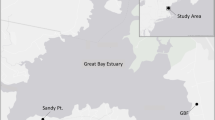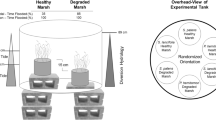Abstract
We evaluated the importance of both tidal inundation and nutrient fertilization as drivers of elevation change in coastal salt marshes. The three sites investigated occurred along a 9-km stretch of the Atlantic Intracoastal Water Way in Central North Carolina. Despite their close geographic proximity, the sites varied in tidal range, elevation within the tidal frame, and stem height and stem density of Spartina alterniflora. Total standing aboveground biomass and marsh surface elevation change (measured by surface elevation tables; SETs) were documented during a 3-year period of nutrient fertilization and for two additional years after fertilization ceased. Measured elevation change rates in control plots varied from 0.2 to 1.2 cm year−1 and were negatively correlated with starting elevation (r 2 = 0.82, p < 0.05). Fertilization resulted in increases in both standing aboveground biomass and marsh surface elevation change. Fertilized sites gained 0.69 to 2.1 cm year−1 during the 3-year application period and 0.02 to 0.97 cm year−1 during the post application period. The magnitude of the fertilization-induced elevation response was mediated by position in the tidal frame with sites that were lower gaining less elevation relative to controls than sites that were higher. The data presented here suggest that nutrient fertilization may be an effective adaptive management strategy for helping minerogenic marshes keep pace with sea level, but that the impact of fertilization may depend on tidal inundation.





Similar content being viewed by others
References
Anisfeld, S.C., and T.D. Hill. 2012. Fertilization effects on elevation change and belowground carbon balance in a Long Island sound tidal marsh. Estuaries and Coasts 35: 201–211.
Blum, L.K. 1993. Spartina alterniflora root dynamics in a Virginia marsh. Marine Ecology Progress Series 102: 169–178.
Boyer, K.E., P. Fong, R.R. Vance, and R.F. Ambrose. 2001. Salicornia virginica in a Southern California salt marsh: seasonal patterns and a nutrient-enrichment experiment. Wetlands 21: 315–326.
Bradley, P.M., and J.T. Morris. 1990. Physical characteristics of salt marsh sediments: ecological implications. Marine Ecology Progress Series 61: 245–252.
Cahoon, D.R., J.C. Lynch, P.F. Hensel, R.M. Boumans, B.C. Perez, B. Segura, and J.W. Day. 2002a. High precision measurement of wetland surface elevation: I. recent improvements to the sedimentation-erosion table. Journal of Sedimentary Research 72: 730–733.
Cahoon, D.R., J.C. Lynch, B.C. Perez, B. Segura, R. Holland, C. Stelly, G. Stephenson, and P.F. Hensel. 2002b. High precision measurement of wetland surface elevation: II. the rod surface elevation table. Journal of Sedimentary Research 72: 734–739.
Cherry, J.A., K.L. McKee, and J.B. Grace. 2009. Elevated CO2 enhances biological contributions to elevation change in coastal wetlands by offsetting stressors associated with sea-level rise. Journal of Ecology 97: 67–77.
Dame, R.F., and P.D. Kenny. 1986. Variability of Spartina alterniflora primary production in the euhaline North Inlet estuary. Marine Ecology Progress Series 32: 71–80.
Darby, F.A., and R.R. Turner. 2008. Effects of eutrophication on salt marsh root and rhizome biomass accumulation. Marine Ecology Progress Series 363: 63–70.
Davis J.L., C.A. Currin, C. O’Brien, C. Raffenberg, and A. Davis. 2015. Living shorelines: coastal resilience with a blue carbon benefit. Plos One 10(11): e0142595.
Deegan, L.A., D.S. Johnson, R.S. Warren, B.J. Peterson, J.W. Fleeger, S. Fagherazzi, and W.M. Wollheim. 2012. Coastal eutrophication as a driver of salt marsh loss. Nature 49: 388–392.
Ensign, S., and C. Currin. 2016. Geomorphic implications of particle movement by water surface tension in a salt marsh. Wetlands. doi:10.1007/s13157-016-0862-4.
Fagherazzi, S., M.L. Kirwan, S.M. Mudd, G.R. Gunterspergen, S. Temmerman, A. D’Alpaos, J. van de Koppel, J.M. Rybczyk, E. Reyes, C. Craft, and J. Clough. 2012. Numerical models of salt marsh evolution: ecological, geomorphic and climatic factors. Reviews of Geophysics 50: RG1002. doi:10.1029/2011RG000359.
Fox, L., I. Valiela, and E. Kinney. 2012. Vegetation cover and elevation in long-term experimental nutrient-enrichment plots in Great Sippewissett Salt Marsh, Cape Cod, Massachusetts: Implications for eutrophication and sea level rise. Estuaries and Coasts 35: 445–458.
French, J.R., and T. Spencer. 1993. Dynamics of sedimentation in a tide-dominated backbarrier salt marsh, Norfolk, UK. Marine Geology 110: 315–331.
Friedrichs, C.T., and J.E. Perry. 2001. Tidal salt marsh morphodynamics: a synthesis. Journal of Coastal Research. 27: 7–37.
Geoghegan, C. E., S. E. Breidenbach, D. R. Lokken, K. L. Fancher, and P. F. Hensel. 2011. Procedures for connecting SET bench marks to the NSRS: establishing GNSS-derived ellipsoid/orthometric heights on surface elevation table bench marks. NOAA Technical report NOS NGS-61, Silver Spring MD.
Gleason, M.L., D.A. Elmer, N.C. Pien, and J.S. Fisher. 1979. Effects of stem density upon sediment retention by salt marsh cord grass, Spartina alterniflora Loisel. Estuaries 2: 271–273.
Graham, S.A., and I.A. Mendelssohn. 2014. Coastal wetland stability maintained through counterbalancing accretionary responses to chronic nutrient enrichment. Ecology 95: 3271–3283.
Ket, W.A., J.P. Schubauer-Berigan, and C. Craft. 2011. Effects of five years of nitrogen and phosphorus additions on a Zizaniopsis miliacea tidal freshwater marsh. Aquatic Botany 95: 17–23.
Kirwan, M.L., G.R. Guntenspergen, A. D’Alpaos, J.T. Morris, S.M. Mudd, and S. Temmerman. 2010. Limits on the adaptability of coastal marshes to rising sea level. Geophysical Research Letters 37: L23806.
Kirwan, M.L., S. Temmerman, E.E. Skeehan, G.R. Guntenspergen, and S. Fagherazzi. 2016. Overestimation of marsh vulnerability to sea level rise. Nature Climate Change. 6: 253–260.
Krone, Ray B. 1962. Flume studies of the transport of sediment in estuarial shoaling processes: final report. Berkeley: Hydraulic Engineering Laboratory and Sanitary Engineering Research Laboratory, University of California.
Leonard, L.A. 1997. Controls of sediment transport and deposition in an incised mainland marsh basin, southeastern North Carolina. Wetlands 17: 263–274.
Leonard, L.A., and A.L. Croft. 2006. The effect of standing biomass on flow velocity and turbulence in Spartina alterniflora canopies. Estuarine, Coastal and Shelf Science 69: 325–336.
Li, H., and S.L. Yang. 2009. Trapping effect of tidal marsh vegetation on suspended sediment, Yangtze delta. Journal of Coastal Research 25: 915–924.
Lynch, J.C., P. Hensel, and D.R. Cahoon. 2015. The surface elevation table and marker horizon technique: a protocol for monitoring wetland elevation dynamics. In Natural resources report NPS/NCBN/NRR-2015/1078, ed. National Park Service. Fort Collins, Colorado.
Mack, M.C., E.A.G. Schuur, M. Syndonia Bret-Harte, G.R. Shaver, and F.S. Chapin III. 2004. Ecosystem carbon storage in arctic tundra reduced by long-term fertilization. Nature 431: 440–443.
Mathworks. 2007. World tides v. 1.03. MATLAB technical computing language. Natick MA: MathWorks, Inc.
McFarlin, C.R., J.S. Brewer, T.L. Buck, and S.C. Pennings. 2008. Impacts of fertilization on a salt marsh food web in Georgia. Estuaries and Coasts 31: 313–325.
Mendelssohn, I.A. 1979. Influence of nitrogen level, form, and application method on the growth-response of Spartina alterniflora in North Carolina. Estuaries 2: 106–112.
Möller, I. 2006. Quantifying saltmarsh vegetation and its effects on wave height dissipation: Results from a UK east coast saltmarsh. Estuarine, Coastal and Shelf Science 69: 337–351.
Morris, J.T. 2007. Ecological engineering in intertidal salt marshes. Hydrobiologia 577: 161–168.
Morris, J.T., and B. Haskin. 1990. A 5-yr record of aerial primary production and stand characteristics of Spartina alterniflora. Ecology 71: 2209–2217.
Morris, J.T., G.P. Shaffer, and J.A. Nyman. 2013a. Brinson review: perspectives on the influence of nutrients on the sustainability of coastal wetlands. Wetlands 33: 975–988.
Morris, J.T., P.V. Sundareshwar, C.T. Nietch, B. Kjerfve, and D.R. Cahoon. 2002. Responses of coastal wetlands to rising sea level. Ecology 83: 2869–2877.
Morris, J.T., K. Sundberg, and C.S. Hopkinson. 2013b. Salt marsh primary production and its responses to relative sea level and nutrients in estuaries at Plum Island, Massachusetts, and North Inlet, South Carolina, USA. Oceanography 26: 78–84.
Mudd, S.M., A. D’Alpaos, and J.T. Morris. 2010. How does vegetation affect sedimentation on tidal marshes? Investigating particle capture and hydrodynamic controls on biologically mediated sedimentation. Journal of Geophysical Research 115: F03044.
Mudd, S.M., S.M. Howell, and J.T. Morris. 2009. Impact of dynamic feedbacks between sedimentation, sea-level rise, and biomass production on near-surface marsh stratigraphy and carbon accumulation. Estuarine, Coastal and Shelf Science 82: 377–389.
National Oceanic and Atmospheric Administration. 2013. Tides and currents, sea level trends. http://tidesandcurrents.noaa.gov/sltrends/sltrends.html. Accessed January 2016.
National Oceanographic and Atmospheric Adminstration. 2015. Vertical Datum Transformation v.3.5. http://vdatum.noaa.gov. Accessed January 2016.
Nyman, J.A., R.D. DeLaune, H.H. Roberts, and W.H. Patrick Jr. 1993. Relationship between vegetation and soil formation in a rapidly submerging coastal marsh. Marine Ecology Progress Series 96: 269–279.
Peet, R.K., T.R. Wentworth, and P.S. White. 1998. A flexible, multipurpose method for recording vegetation composition and structure. Castanea 63: 262–274.
Plumb, R.H. 1981. Procedures for handling and chemical analyses of sediment and water samples. In Environmental Laboratory. Vicksburg, Miss: U.S. Army Engineer Waterways Experiment Station.
Rodriguez, A.B., S.R. Fegley, J.T. Ridge, B.M. VanDusen, and N. Anderson. 2013. Contribution of aeolian sand to backbarrier marsh sedimentation. Estuarine, Coastal and Shelf Science 117: 248–259.
Schubauer, J.P., and C.S. Hopkinson. 1984. Above- and belowground emergent macrophyte production and turnover in a coastal marsh ecosystem, Georgia. Limnology and Oceanography 29: 1052–1065.
Slocum, M.G., and I.A. Mendelssohn. 2008. Effects of three stressors on vegetation in an oligohaline marsh. Freshwater Biology 53: 1783–1796.
Turner, R.E. 2011. Beneath the salt marsh canopy: loss of soil strength with increasing nutrient loads. Estuaries and Coasts 34: 1084–1093.
Voss, C.M., R.R. Christian, and J.T. Morris. 2013. Marsh macrophyte responses to inundation anticipate impacts of sea-level rise and indication ongoing drowning of North Carolina marshes. Marine Biology 160: 181–194.
Wigand, C., P. Brennan, M. Stolt, M. Holt, and S. Ryba. 2009. Soil respiration rates in coastal marshes subject to increasing watershed nitrogen loads in Southern New England, USA. Wetlands 29: 952–963.
Wigand, C., E. Davey, R. Johnson, K. Sundberg, J. Morris, P. Kenny, E. Smith, and M. Holt. 2015. Nutrient effects on belowground organic matter in a minerogenic salt marsh, North Inlet, SC. Estuaries and Coasts 38: 1838–1853.
Wolaver, G.T., R.F. Dame, J.D. Spurrier, and A.B. Miller. 1988. Sediment exchange between and euhaline salt marsh in South Carolina and the adjacent tidal creek. Journal of Coastal Research 4: 17–26.
Acknowledgments
Elevation data were collected by Mike Greene. Anna Hilting read SETs and managed SET database. Luke Snedaker generated tidal datums for this work. We thank Nathan McTigue, Ellen Herbert, Cathy Wigand, and two anonymous reviewers for editorial comments. Funding for this project was provided by grants to Carolyn Currin and James Morris from the Defense Coastal Estuarine Research Program. The scientific results and conclusions, as well as any views or opinions expressed herein, are those of the author(s) and do not necessarily reflect the views of NOAA or the Department of Commerce and should not be construed as an official US Department of Defense position or decision unless so designated by other official documentation.
Author information
Authors and Affiliations
Corresponding author
Additional information
Communicated by John C. Callaway
Rights and permissions
About this article
Cite this article
Davis, J., Currin, C. & Morris, J.T. Impacts of Fertilization and Tidal Inundation on Elevation Change in Microtidal, Low Relief Salt Marshes. Estuaries and Coasts 40, 1677–1687 (2017). https://doi.org/10.1007/s12237-017-0251-0
Received:
Revised:
Accepted:
Published:
Issue Date:
DOI: https://doi.org/10.1007/s12237-017-0251-0




